Gateway FPD2485W: 24" LCD Beauty or Beast?
by Jarred Walton on February 22, 2007 10:00 AM EST- Posted in
- Displays
Features - OSD
One of the more interesting aspects of this LCD is its On-Screen Display (OSD). Depending on how you intend to use the LCD, you may find yourself accessing the OSD infrequently or on a regular basis. If you use multiple inputs, you will use the OSD to select among the various connected devices. We definitely get the impression that Gateway was trying to make a "cool" OSD. Rather than having actual buttons, the right black border hides touch sensitive areas that light up when you press the menu option.
The initial press of the menu button brings up several quick access options to get you to the most commonly used areas. At the top is a "scrollable" area where you can select among several different color themes: movie, web, picture, game, warm, cool, and user. These options basically adjust the brightness, contrast, and color levels to preset values, with the exception of "user" which is for user-defined adjustments. The next four options provide quick access to input selection, picture in picture settings, and video adjustments. The bottom option takes you to the main menu, which is necessary in order to reach a few other areas.
Choosing among the six available inputs is pretty simple. After exiting the Input Select option, you choose the appropriate input and you're done. The currently active input is not listed, which is why there are only five inputs shown - we used the DVI input for most of our testing. It's a bit odd that they don't simply put the sixth input in place of the Cancel option, however, so that all of the menu items would always be in the same position.
Outside of the initial menu and input selector, the way the On-Screen Display functions changes - somewhat counter-intuitively, we might add. The remaining menus move the various options into a gray area on the left side of the OSD, and the top "scroll" buttons are now used to move up and down among the options. These buttons aren't particularly sensitive, so sometimes you will tap a button and get no result while other times you will push it once and the selection will jump twice. Above you can see the images of the Picture, PIP, and Advanced menus; the various submenus are self-explanatory and we didn't bother capturing screenshots taking pictures.
The final two OSD menus contain items related to adjustment of signal properties. If you are using a digital connection, several of the items are grayed out - Sharpness, Noise Reduction, Film Mode, and Video Enhance all deal with improving the quality of analog signals. Video Scaling allows you to customize how non-native resolutions are handled, including the option of displaying the content at a one-to-one ratio (unscaled). The Panoramic function is a nonlinear stretch that is only available with analog connections.
The OSD certainly provides all of the options we like to see, but navigating through the various menus is not quite as straightforward as we would like. This is due in part to the less sensitive "scroll" buttons at the top of the menu - or at least they didn't seem to be quite as responsive as the other menu buttons. If you find yourself frequently accessing the OSD menus, it can be a little irritating at times, and it seems like things could have been made easier by turning the "scroll" area into a couple more buttons and eliminating the need to move up and down among the various options. Still, the OSD does provide a good set of adjustments, and while it could have been streamlined it works well enough to get the job done.
One of the more interesting aspects of this LCD is its On-Screen Display (OSD). Depending on how you intend to use the LCD, you may find yourself accessing the OSD infrequently or on a regular basis. If you use multiple inputs, you will use the OSD to select among the various connected devices. We definitely get the impression that Gateway was trying to make a "cool" OSD. Rather than having actual buttons, the right black border hides touch sensitive areas that light up when you press the menu option.
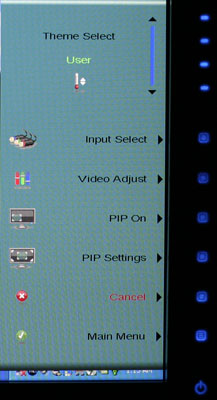 |
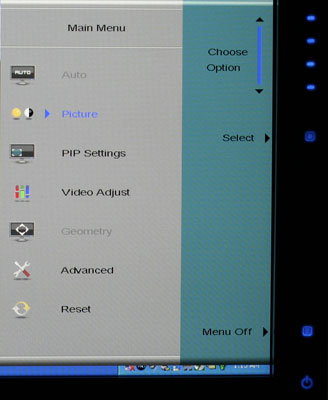 |
| Click to enlarge | |
The initial press of the menu button brings up several quick access options to get you to the most commonly used areas. At the top is a "scrollable" area where you can select among several different color themes: movie, web, picture, game, warm, cool, and user. These options basically adjust the brightness, contrast, and color levels to preset values, with the exception of "user" which is for user-defined adjustments. The next four options provide quick access to input selection, picture in picture settings, and video adjustments. The bottom option takes you to the main menu, which is necessary in order to reach a few other areas.
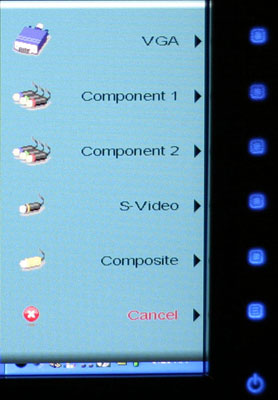 |
| Click to enlarge |
Choosing among the six available inputs is pretty simple. After exiting the Input Select option, you choose the appropriate input and you're done. The currently active input is not listed, which is why there are only five inputs shown - we used the DVI input for most of our testing. It's a bit odd that they don't simply put the sixth input in place of the Cancel option, however, so that all of the menu items would always be in the same position.
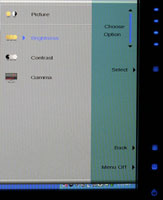 |
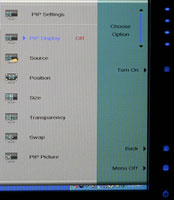 |
 |
| Click to enlarge | ||
Outside of the initial menu and input selector, the way the On-Screen Display functions changes - somewhat counter-intuitively, we might add. The remaining menus move the various options into a gray area on the left side of the OSD, and the top "scroll" buttons are now used to move up and down among the options. These buttons aren't particularly sensitive, so sometimes you will tap a button and get no result while other times you will push it once and the selection will jump twice. Above you can see the images of the Picture, PIP, and Advanced menus; the various submenus are self-explanatory and we didn't bother capturing screenshots taking pictures.
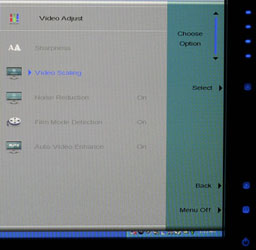 |
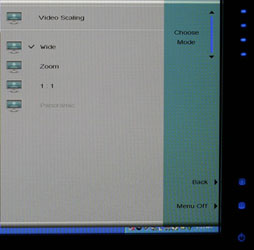 |
| Click to enlarge | |
The final two OSD menus contain items related to adjustment of signal properties. If you are using a digital connection, several of the items are grayed out - Sharpness, Noise Reduction, Film Mode, and Video Enhance all deal with improving the quality of analog signals. Video Scaling allows you to customize how non-native resolutions are handled, including the option of displaying the content at a one-to-one ratio (unscaled). The Panoramic function is a nonlinear stretch that is only available with analog connections.
The OSD certainly provides all of the options we like to see, but navigating through the various menus is not quite as straightforward as we would like. This is due in part to the less sensitive "scroll" buttons at the top of the menu - or at least they didn't seem to be quite as responsive as the other menu buttons. If you find yourself frequently accessing the OSD menus, it can be a little irritating at times, and it seems like things could have been made easier by turning the "scroll" area into a couple more buttons and eliminating the need to move up and down among the various options. Still, the OSD does provide a good set of adjustments, and while it could have been streamlined it works well enough to get the job done.










77 Comments
View All Comments
strikeback03 - Monday, February 26, 2007 - link
thanks, that makes sense. I assumed the LUT was applied to everything the video card sent to the monitor. However playing with my calibration settings in the GretagMacbeth software and also with the nVidia controls provided in their settings package did not touch the video image.My current desktop monitor absolutely destroys blacks in it's out-of-the-box configuration. Calibration can make most stuff OK (not great) but since it does not affect video, movies such as the Matrix or V for Vendetta are unwatchable.
JarredWalton - Thursday, February 22, 2007 - link
I didn't notice any issues with blacks being "crushed", but there were some other issues I'll address shortly in regards to colors.chizow - Thursday, February 22, 2007 - link
Crushed blacks are a pretty bad problem with miscalibrated displays. Basically if you use the provided calibration software EzTune and calibrate the display based on what the captions tell you, you'll get an overly dark setting with really high relative contrast. In games and movies, the result is horribly crushed blacks with no detail/difference in blacks and brain-searing light/particle effects. For instance, in Dark Messiah, I felt like I was running around with a blindfold on...except for the blinding light coming off my Lightning Shield, which I avoided using at all costs.Justin Case - Friday, February 23, 2007 - link
Note that most lossy video compression algorithms will eliminate more detail from very dark (or very bright) colors than from midtones, so if a DVD appears to have crushed blacks, that could be just a poor encode.Most 3D games have a local gamma setting, so a wrong value there can also make things look bad.
Having said that, poor loss of detail and posterization in dark areas is a problem with some LCD panels.
Justin Case - Thursday, February 22, 2007 - link
Laptop panels are typically picked for their low power consumption, not color accuracy, which makes those values a bit odd. What model is your laptop? And have you measured other monitors with the same calibrator?Anyway, simple calibrators won't measure things like color variation with angle of view, light bleed, etc. (which aren't issues for CRTs, but are for LCDs), so the deviation alone isn't a complete measure of the overall image quality.
strikeback03 - Friday, February 23, 2007 - link
Thinkpad T43 with the Flexview (IPS) screen. There is some slight contrast change with viewing angle, but it's the best I have seen in a laptop. Other displays I have checked include my desktop LCD (cheap, with predictably bad colors, which is why I'm looking to replace it), a cheap old CRT (not very good), and a few ViewSonic CRTs at work (good results from calibration on all).JarredWalton - Friday, February 23, 2007 - link
You should see the results from an older laptop I have. Even calibrated, dE is still a whopping 7.8! There are a few colors (blue and yellow I think) where I couldn't get dE to anything lower than 16-20. Heh. If you've got a display on a laptop that can get an average dE of anything less than 2.0, you're doing *VERY* well! My future laptop reviews will take a closer look at the laptop LCD quality....StevenG - Thursday, February 22, 2007 - link
Some sites have reported extensively on the issue of input lag with LCDs. They have found that if you drive a CRT and an LCD at the same time, the image on the LCD will often lag the CRT by 1 or more frames. So what you are seeing on screen with an LCD is actually up to 50 or so ms behind the image that is being produced by the video card. This is one reason why I still don't use LCDs for gaming (the other reason being low refresh rates, which means a low frames/second limit if you enable vsynch - I refresh at 100 Hz at 1280x1024 on my 21" CRT, and there isn't an LCD on the market that can match that).I would like to see Anandtech explore this issue of LCD lag.
Justin Case - Thursday, February 22, 2007 - link
You have a 5:4 aspect ratio CRT? If not, you should be using 1280x960. If you pick 1280x1024, most games will assume you're using a 5:4 monitor (LCD), and the image will be slightly distorted (vertically compressed).JarredWalton - Thursday, February 22, 2007 - link
Refresh rates are one of the advantages of CRTs that nothing else is currently able to match, unfortunately. I wish we could get 100 Hz refresh rates on LCDs, if only to avoid reduce the appearance of screen tear with vsync disabled, but the digital connection precludes that option for now.As for input lag, the pixel response times can make the LCD always appear one frame behind what is supposed to be shown, i.e. the GPU sends frame 1, and then 1/60 of a second later it sends frame 2, etc. The LCD receives frame one and the pixels start to transition, but the transition takes anywhere from 2-20ms (depending on colors and LCD). If we just say it takes ~16ms, that's one screen refresh. I've heard other LCDs may buffer input so that there's an additional lag, but if so I can't say that my eyes are sharp enough to detect it.